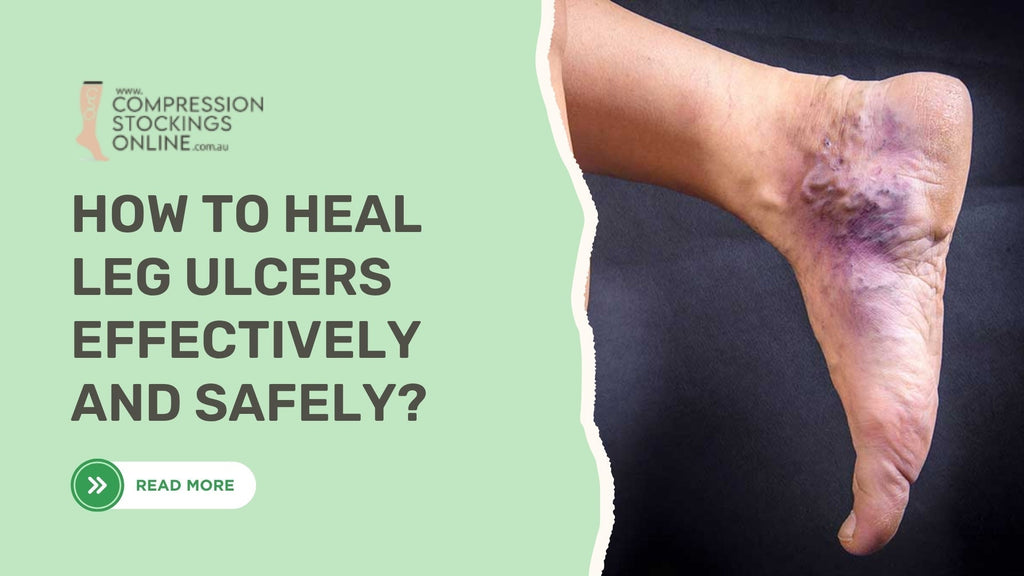
If you’ve noticed a sore on your leg that just won’t heal, you’re not alone. Leg ulcers can be painful, slow to heal, and affect your daily life, making simple activities difficult and uncomfortable.
Up to 3% of Australians are estimated to develop a chronic venous leg ulcer in their lifetime, with approximately 400,000 people affected at any one time. Understanding what causes these ulcers and how to care for them is key to getting back on your feet.
In this article, we’ll explain what leg ulcers are, how to spot early signs, practical steps to help healing, and how compression garments can support recovery. You’ll also learn when it’s important to seek medical help and how to prevent ulcers from coming back.
Understanding What Causes Leg Ulcers: The Root of the Problem
Knowing what causes your leg ulcer is the first step to healing it correctly. Studies say, around 50,000 Australians are living with diabetes-related foot ulcers, while 300,000 are considered at risk.

Let’s break down the main reasons why these ulcers happen, so you can understand how to tackle the problem properly.
Venous Insufficiency (Venous Leg Ulcers)
Venous Insufficiency is the most common cause, responsible for about 60-80% of leg ulcers. When the veins in your legs don’t push blood back to the heart properly, pressure builds up in the legs. This causes swelling and eventually damages the skin, leading to ulcers.
Think of it like a traffic jam in your veins; the blood gets stuck and causes trouble.
Arterial Disease (Arterial Ulcers)
Sometimes, the arteries, which carry blood to your legs, get narrow or blocked, usually due to peripheral artery disease. When blood can’t flow well, the tissues don’t get enough oxygen and nutrients, causing damage and ulcers. These ulcers usually appear on the feet or lower legs and can be quite painful.
Neuropathy (Diabetic and Neuropathic Ulcers)
If you have diabetes, neuropathy (nerve damage) might reduce feeling in your feet or legs. This means small injuries might go unnoticed and turn into ulcers over time because you don’t feel the pain to protect yourself.
Bedsores (Pressure Ulcers)
When constant pressure is applied to certain areas, especially over bones, blood flow gets restricted and the skin breaks down, leading to bedsores. This happens mostly to people who can’t move much, like those who are bedridden or in wheelchairs.
Mixed Ulcers
Sometimes ulcers happen because of a mix of venous and arterial problems. These need careful attention since the treatment differs from ulcers caused by just one issue.
Other Less Common Causes
Leg ulcers can also come from infections (bacterial or fungal), inflammatory conditions like vasculitis, or rare diseases such as pyoderma gangrenosum and Buruli ulcer.
Deep Vein Thrombosis (DVT)
DVT, caused by blood clots in deep veins, can damage veins and valves, leading to chronic venous insufficiency and post-thrombotic syndrome (PTS). PTS develops in 20-50% of DVT patients, with 5-10% experiencing severe cases, including leg ulcers.
Key Risk Factors
Certain things increase your chances of getting leg ulcers:
- Getting older
- Being overweight
- Having diabetes
- Smoking
- Limited movement
- Previous leg injuries or varicose veins
Knowing the exact cause helps in choosing the right treatment, so in the next sections, we’ll talk about how you can start healing based on these causes.
Spotting the Signs Early: What to Look For?
Catching a leg ulcer early can make all the difference in healing quickly. Let’s talk about the common signs so you know when it’s time to take action.

Persistent Open Sore
If you have a wound on your leg or foot that just won’t heal after a few weeks, that’s a key warning sign. Unlike a simple scrape, ulcers stay open and may even get worse over time.
Pain or Tenderness
Many ulcers cause aching, burning, or tenderness around the sore. But sometimes, especially with diabetes-related ulcers, you might not feel much because of nerve damage.
Swelling
Swelling around the lower leg or ankle often happens with venous leg ulcers. It can make your skin feel tight or uncomfortable, so keep an eye on any puffiness that sticks around.
Skin Discoloration
Look for patches of darkened, red, or purplish skin near the sore. This usually means poor blood flow or ongoing inflammation, both of which need attention. To learn how to support healthy circulation, check out How to Improve Blood Flow to Feet.
Changes in Skin Texture
Before an ulcer even appears, the skin may start to feel shiny, thin, or tough. It can also get dry or itchy in that spot, signaling trouble underneath.
Drainage or Odor
Ulcers often leak fluid that can be clear, yellow, or greenish. If you notice a bad smell, it might mean the sore is infected and needs care right away.
Signs of Infection
Watch out for redness spreading beyond the sore, warmth, increased swelling, pus, or if you develop a fever. These are signs that the ulcer may be infected, and urgent help is needed.
Loss of Sensation
Numbness or tingling around the leg or foot, especially in people with diabetes, can mean nerve damage. This makes it easier for ulcers to form because you might not notice injuries right away.
Knowing these signs helps you spot trouble early and get the right care. In the next part, we’ll discuss what you can do to help your ulcer heal.
Taking Action: Practical Steps to Help Heal Your Leg Ulcer
Healing a leg ulcer takes a mix of care, patience, and the right steps. Here’s what you can start doing today to help your sore get better.

Get a Proper Diagnosis
Before anything else, it’s important to see a healthcare professional. They’ll figure out what type of ulcer you have and what’s causing it, because the best treatment depends on knowing the root of the problem.
Keep the Wound Clean
Gently clean your ulcer using saline or a wound cleanser your doctor recommends. This helps remove dirt and lowers the chance of infection, giving your body the best chance to heal.
Use the Right Dressings
Dressings should keep the wound moist while keeping the skin around it dry. This balance supports faster healing and keeps you comfortable during the process.
Compression Therapy (For Venous Ulcers)
If your ulcer is due to venous problems, wearing compression bandages or stockings is key. They help push the blood back up your legs, reduce swelling, and speed up healing. The strongest, multi-layer compression works best but should be applied by someone trained to avoid harm.
Elevate Your Legs
Raising your legs above heart level several times a day lowers swelling and helps blood flow better. It’s a simple habit that makes a big difference.
Stay Active
Gentle movement, like walking or calf exercises, keeps blood moving and supports healing. It might seem small, but staying active helps your legs in more ways than one.
Manage Pain
If the ulcer hurts, use pain relief as your doctor suggests. Don’t hesitate to talk to your healthcare provider if pain lasts or worsens, they can help you find better relief.
Control Underlying Health Conditions
Conditions like diabetes or high blood pressure can slow healing. Keeping these under control helps your body focus on fixing the ulcer.
Prevent Infection
Watch for redness, swelling, pus, or fever. If you notice any, get medical help quickly to stop infections from worsening.
Follow Up Regularly
Keep all your medical appointments. Your doctor needs to check how well your ulcer is healing and tweak treatments if needed.
Seek Advanced Treatments if Needed
Sometimes, ulcers don’t heal with basic care. In those cases, specialists might recommend procedures like endovenous ablation or surgery to fix the blood flow and help with healing.
These practical steps put you in control of your healing journey. Next, we’ll look Practical Steps to help heal your legs.
Why Compression Garments Matter for Healing Leg Ulcers?
Up to 70% of venous leg ulcers will heal within 12 weeks with appropriate treatment if adequate compression is applied and patients adhere to compression treatment.

- Speeds Up Healing - Compression reduces healing time for venous leg ulcers compared to no compression.
- Improves Blood Flow - Graduated pressure pushes blood up leg veins, reducing pooling and swelling.
- Reduces Swelling and Pain - Helps decrease leg and ankle swelling (edema) and eases pain around ulcers.
- Prevents Ulcer Recurrence - Wearing compression stockings daily after healing lowers the risk of ulcers coming back.
- Supports Quality of Life - Regular use improves mobility and comfort for those with leg ulcers.
- Needs Consistent Use - Sticking to compression therapy is key; irregular use delays healing and increases recurrence risk.
Explore comfortable compression stockings and effective compression wraps to support your healing journey. To understand more about how these work, check out What Do Compression Stockings Do.
When to Seek Medical Help: Knowing Your Limits
- Wound Isn’t Healing - If your leg ulcer doesn’t show improvement after two weeks of proper care, it’s time to see a healthcare professional.
- Signs of Infection - Watch for redness, warmth, swelling, pus, bad smell, or fever; these can mean a serious infection needing urgent treatment.
- Severe or Worsening Pain - New or increasing pain around the ulcer may signal complications that require prompt medical check.
- Spreading Redness or Swelling - Redness or swelling moving beyond the ulcer might indicate cellulitis or deeper infection.
- Black or Discolored Tissue - Black or blue skin near the wound suggests poor blood flow and needs urgent attention.
- Numbness or Loss of Sensation - Sudden numbness or tingling could mean nerve damage or worsening circulation.
- Ulcers in People with Diabetes or Poor Circulation - If you have diabetes or circulation issues, seek medical advice for any ulcer, even minor ones.
- General Health Declines - Chills, confusion, or feeling very unwell with an ulcer require immediate medical care.
Conclusion: Your Path to Healthier Legs Starts Today
We’ve covered how understanding the causes of leg ulcers and spotting their early signs can set you on the right track to healing. Taking practical steps like keeping wounds clean, elevating your legs, and managing health conditions all play a part. Most importantly, using compression stockings and wraps consistently speeds up healing and helps prevent ulcers from coming back.
Ready to give your legs the support they need? Explore our collection at Compression Stockings Online, featuring top brands like Jobst, Juzo, Sigvaris, and Venosan. Find the right compression gear to help your legs heal faster and feel better every day.
Frequently Asked Questions
What is the fastest way to cure a leg ulcer?
Keeping the wound clean, using proper dressings, elevating your legs, and wearing compression stockings consistently are the fastest ways to promote healing. Early medical advice is important to address the underlying cause.
Should you moisturise leg ulcers?
Moisturising the skin around the ulcer helps prevent dryness and cracking, but avoid putting creams directly on open wounds unless directed by your doctor.
Can I put antiseptic cream on a leg ulcer?
Using antiseptic creams on leg ulcers isn’t usually advised as they can delay healing; instead, proper wound cleaning with saline and suitable dressings is preferred.
When should I see a doctor about my leg ulcer?
If your ulcer hasn’t improved after two weeks of proper care, or if you notice signs of infection like redness, pus, or fever, seek medical advice promptly.

Leave a comment